
Search results
WWI Centenary Street Name Trail
The onset of World War I had a profound effect on society, evident in the naming of local streets in Daceyville and Pagewood.
When construction of Daceyville began in 1912, early street names were inspired by the European exploration of Australia. For instance, Banks Avenue commemorates Sir Joseph Banks, the renowned naturalist who sailed into Botany Bay with Captain Cook in 1770. This trend shifted with the outbreak of WWI, which captured the hearts and minds of society. Later streets were named to honour heroic servicemen and important military leaders.
The WWI Centenary Street Name Trail pays tribute to 17 men, most of whom distinguished themselves during WWI and WWII. Initially unveiled in 2016, the trail's 17 interpretive panels are being refreshed and updated in 2025.
Download your copy of the WWI Centenary Street Name Trail
For more on the history of Daceyville see Audaciousville.
This project was initially made possible with the assistance of the Botany Historical Trust, Hon Matt Thistlethwaite MP, Member for Kingsford Smith & ‘Department of Veterans’ Affairs, Anzac Centenary Local Grants Program. Bayside Council has continued work on this project by carrying out the renewal of signage along the trail.
Daceyville

1. General Bridges Crescent
Major General Sir William Throsby Bridges (1861–1915) is considered to be Australia’s first notable general. Prior to the war
He held several military positions and established Duntroon, Australia’s first military college.
When war broke out, Bridges was given the task of raising troops. His insistence that Australians remain together, not merely absorbed into Commonwealth Forces, led to the formation of the AIF.
At war, Bridges led the first division to land at Anzac Cove. He was wounded on 15 May 1915 and died three days later. He is one of only two Australians who served in WWI to have their remains returned to Australia for burial.
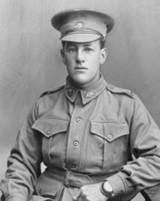
2. Captain Jacka Crescent
Albert Jacka (1893–1932) has been described as ‘Australia’s greatest front-line soldier’. In 1915 he became the first Australian in WWI to be awarded the Victoria Cross for his ‘conspicuous bravery’ at Courtney’s Post, Gallipoli.
After becoming a national hero, Jacka went on to fight in France. In August 1916 at Pozières, he led his platoon rescuing 40 Australians captured by the Germans.
For these actions Jacka was awarded a Military Cross. According to Anzac historian Charles Bean, this mission was ‘the most dramatic and effective act of individual audacity in the history of the AIF.’
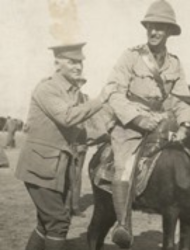
3. Sergeant Larkin Crescent
Edward Rennix Larkin (1880–1915), the son of a miner, was a journalist, sportsman, policeman and politician.
As Secretary of the NSW Rugby Football League he was an organised leader, with a keen social conscience. In December 1913 he won the seat of Willoughby for the Labor Party in State Parliament.
Soon after the outbreak of war, Larkin enlisted in the 1st Battalion as a sergeant. After showing ‘conspicuous gallantry’ at Gallipoli on 25 April 1915, he was killed the same day at Pine Ridge.
He is commemorated on the Lone Pine Memorial, Gallipoli with his brother, Martin, who was also killed that day.
Edward Rennix Larkin is pictured on the left.
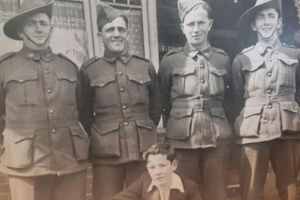
4. Colenso Crescent
In 1961, this street was renamed after the Colensos. During WWII, four of the family’s five sons joined the AIF. Together, Bill, Frank, Ted and Ray went off to fight in the jungles of Malaya.
Unfortunately all four brothers were listed as missing in 1942. In her grief, their mother Winifred burst out with the words ‘Oh dear and my boys do so hate rice’.
In 1945 only two of her sons, Frank and Ted came home. Eldest son Bill, left behind three daughters and a son, born after his father had sailed for Malaya. Ray, a budding poet, was just 21 when he was declared missing.

5. Colonel Braund Crescent
Colonel Braund (1866–1915) was the commanding officer of the 2nd Battalion, which landed at Gallipoli on 25 April 1915 as part of the second and third waves.
Unfortunately Braund was killed just nine days later. On the night of 3–4 May, Braund was accidently shot by a sentry as he cut through the scrub back to brigade headquarters. Being slightly deaf he failed to hear the sentry’s challenge.
Braund is buried at Beach Cemetery, Gallipoli. He was one of two members of the NSW Parliament to lose their lives at Gallipoli. Sergeant Edward Larkin, who is also honoured here in Daceyville, is the other.

6. Joffre Crescent
Joseph Jacques Césaire Joffre (1852–1931) was Commander-in-Chief of the French forces on the Western Front from 1914 until the end of 1916.
Following his successful counter-offensive against the Germans at the First Battle of the Marne, in early September 1914, he was declared the ‘saviour of France.’ Although a victory for the Allies, it led to four years of trench warfare on the Western Front. After the long and costly Battle of Verdun in 1916, Joffre resigned and was created Marshal of France.
In 1917, Joffre served as head of the French military mission to the United States and in 1918 was President of the Supreme War Council.
Joseph Jacques Césaire Joffre is pictured on the left.

7. Haig Avenue
From December 1915 until the end of WWI, Field Marshal Douglas Haig (1861–1928) was the Commander-in-Chief of the British Expeditionary Force.
During this time he oversaw a number of key battles, including the Battle of the Somme, the Third Battle of Ypres, and the
Hundred Days Offensive, which led to the end of the war. Because of the extremely high Allied casualty rate during WWI, Haig has since become a figure of controversy.
After the war, Haig served his country by helping to form the Royal British Legion. Still operating today, the organisation aims to support Britain’s armed services, both past and present.
Pagewood

8. Birdwood Avenue
British Major General William Riddell Birdwood (1865–1951) was a rare leader. His courage was highly respected by the Australian and New Zealand troops he led.
Appointed by Kitchener, it was Birdwood who gave the name ‘Anzac’ to the cove at which they landed at Gallipoli on 25 April 1915. ‘Birdie’ also commanded the successful evacuation from the Peninsula during December 1915.
Described as the ‘Soul of Anzac’, by late 1917 he was in command of all five divisions of the AIF. After the war he toured Australia and New Zealand to great acclaim. However, his dream to become Governor-General of Australia was never realised. In 1925 Birdwood was promoted to Field Marshal.
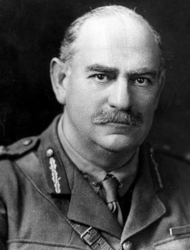
9. Monash Gardens
Soldier, engineer, scholar, and administrator, John Monash (1865–1931) was the son of Prussian Jewish immigrants and arguably Australia’s greatest ever general.
Appointed to lead the 4th Infantry Brigade of the AIF in 1914, Monash fought at Gallipoli and in France taking command of the Australian Corps in May 1918. He was knighted in the field at Bertangles by King George V. It was the first knighthood bestowed on a commander in the field in nearly 200 years.
After overseeing the repatriation of 160,000 Diggers, Monash became a spokesman for returned soldiers, and was active in education and civic life.
Some 300,000 mourners attended his state funeral.

10. Kenny Road
Thomas James Bede Kenny (1896–1953) was born in Paddington, Sydney and enlisted in the AIF in August 1915.
Kenny was awarded the Victoria Cross for his actions at Hermies, France, on 9 April 1917, while serving with the 2nd Battalion. Under heavy fire from a machine gun post, Kenny single- handedly rushed the enemy, hurling three bombs and destroying the post. Wounded, he seized the gun and took the surviving German soldiers prisoner.
Kenny returned home to a hero’s welcome in 1918 on HMAT Medic, along with other Victoria Cross recipients. He became a travelling salesman and was buried in Botany Cemetery, now Eastern Suburbs Memorial Park.

11. Jellicoe Park
Sir John Rushworth Jellicoe (1859–1935) joined the Royal Navy at the age of 12.
In 1916, as Admiral, Jellicoe was in command of the British Grand Fleet when it fought the German fleet at the Battle of Jutland. This was the biggest naval engagement of WWI. Although ultimately a strategic victory for the British, Jellicoe’s cautious approach to naval warfare was sometimes criticised.
Jellicoe was appointed First Sea Lord in December 1916, but was dismissed a year later. He became Admiral of the Fleet in 1919 and served as Governor-General of New Zealand during the early 1920s. In 1925 he became 1st Earl Jellicoe.
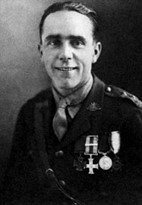
12. Maxwell Road
Joseph Maxwell (1896–1967) was the second most highly decorated Australian soldier of WWI. In just over 12 months Maxwell was awarded the Distinguished Conduct Medal, the Military Cross and Bar and the Victoria Cross.
Maxwell’s Victoria Cross was earned in France in 1918, after his Company Commander was wounded and he took charge. Maxwell single-handedly captured two machine guns, was briefly taken prisoner and drew a concealed pistol to escape with his men under heavy fire. He later returned to capture the post.
After the war Maxwell worked as a gardener and journalist. He died in Matraville and was cremated at Botany Cemetery, now Eastern Suburbs Memorial Park.

13. Murray Road
Tasmanian-born soldier/farmer ‘Mad’ Harry Murray (1880–1966) was Australia’s most decorated WWI soldier. Leaving school aged 14 to help run the family farm, he also worked as a mail courier on the WA goldfields.
Enlisting as a private in the AIF with the 16th Battalion, Murray landed at Gallipoli on 25 April 1915 earning a Distinguished Conduct Medal for ‘exceptional courage, energy and skill’ with a machine-gun crew.
In France, Murray fought at Mouquet Farm, and Bullecourt, winning a Victoria Cross for an attack on Stormy Trench in 1917. After the war, he returned home to the work he loved, as a grazier. He never attended an Anzac Day March.

14. Keysor Road
Of English Jewish heritage, Leonard Maurice Keysor (1885–1951) spent 10 years in Canada before arriving in Sydney in 1914. Enlisting in the AIF, he landed at Gallipoli on 25 April 1915 with the 1st Battalion.
Keysor earned the Victoria Cross for his outstanding bravery as a bomb-thrower at Lone Pine during August. For 50 hours he smothered or lobbed back the Turkish bombs that fell in the trenches. On several occasions he caught the bombs mid-flight. Wounded, he refused medical aid and his actions saved the trench.
He also served at Pozières and Villers- Bretonneux, and was promoted to Lieutenant in July 1917. After the war Keysor returned to London.
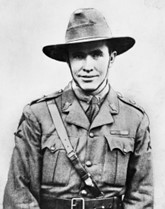
15. Towner Gardens
Pastoralist Edgar Towner (1890–1972) enlisted as a private in the AIF on 4 January 1915. By March 1916, he was a sergeant in the 25th Battalion fighting in Belgium and France. In 1917 Towner was commissioned lieutenant and in 1918 won the Military Cross at Morlancourt while fighting with the 2nd Machine Gun Battalion.
Twice mentioned in despatches ‘for devotion to duty and consistent good work’, Towner received the Victoria Cross for the attack on Mont St Quentin.
On his return to Queensland, Towner took up jackerooing and itinerant work before becoming a partner in Kaloola station and developing a graziers’ business.

16. Wark Avenue
Blair Anderson Wark (1894–1941), a quantity surveyor from Bathurst, was appointed to the 30th Battalion of the AIF on 5 August 1915. By 1916 he was a captain and company commander and reached the Western Front in June. Wounded at Fromelles, he was promoted major in 1917.
In 1918, aged only 24, Wark was given temporary command of the 32nd Battalion in operations against the Hindenburg line, where he rescued 200 American soldiers and surprised and captured 50 Germans near Magny-la-Fosse.
Wark was awarded the Victoria Cross for bravery and at his military funeral it was said that he ‘liked the wind in his face and lived the life of three men.’
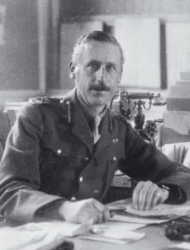
17. White Road
Co-founder of the AIF, a would-be barrister and former President of the Brisbane Stock Exchange, Cyril Brudenell White (1876–1940) became Chief of Staff of the 1st Australian Division AIF in 1914. He organised the first contingent to be in Egypt by December of 1914 and planned the landing at Gallipoli.
Promoted to Brigadier General in October 1915, Brudenell White served as Chief of Staff with Generals Bridges and Birdwood. Receiving five foreign decorations, he was appointed aide-de-camp to King George V and was mentioned in despatches five times.
Recalled in 1940 to become Army Chief of Staff, Brudenall White’s appointment was short as he died in August in the Canberra air disaster.
